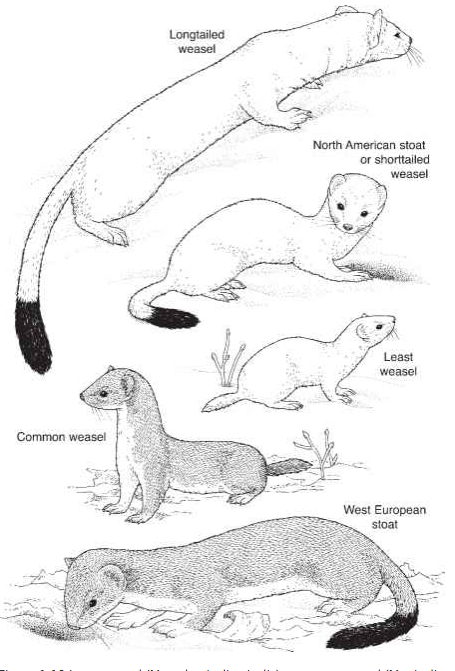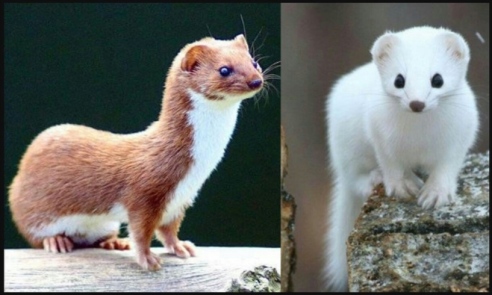“How can you tell the difference between a white weasel and an ermine?”

The Nine-Year-Old was diagnosed with atypical pneumonia late last week, which has thrown us a bit off schedule here at Caterpickles Central. On the scale of how bad does this illness seem, atypical pneumonia appears to be roughly the equivalent of bronchitis.* Not nearly as bad as what you thought of when you read the word pneumonia, but a tough slog nonetheless. She’s on the mend now, though, so I feel free to resume work on our regularly scheduled Monday post (ahem).
After listening to The Nine-Year-Old’s theatrical rendition of Elys Dolan’s book Weasels, Daddyo wanted to know how The Nine-Year-Old could be sure that the white weasel who appears briefly in the book to clumsily sabotage the weasels’ dastardly plot to take over the world is actually a white weasel, and not an ermine spy.
How can you tell the difference between a white weasel and an ermine?
Scientifically speaking, ermines are weasels. We just don’t typically call them that. Still, both the least weasel (the animal Americans typically refer to when they use the term weasel) and ermines belong to the weasel family (the genus Mustela).
The following drawing from the Ecology Center blog shows the size differences between five types of weasels common to North America and Europe. For the purposes of this post, we’re going to focus on two: the North American stoat (Mustela erminea, commonly known as stoats or ermines), and the least weasel (Mustela nivalis nivalis, commonly known as weasels).

Five types of weasels common to North America and Europe, shown in their winter coats. Drawings are to scale. (Source: Ecology Center)
Depending on the time of year in which you spot one, there are three main ways to tell ermines and least weasels apart:
- Size
- Their belly fur (summer only)
- Their tails
Size
Ermines are typically larger than least weasels. On average, adult ermines are 7-13 inches long, and can weigh up to 5 oz. Adult least weasels, on the other hand, generally top out at 8 inches in length and 2 oz in weight.
I point this difference out with absolute confidence that it will help someone. Sadly, unless an adult ermine were obliging enough to pose next to a fully grown least weasel for me out in the wild, size is not going to help me much. Let’s move on.
Belly fur (summer only)
In summer, the backs, outer legs, tails, and heads of both least weasels and ermines are covered with a rich brown fur that ranges in color from a sandy tan to a dark chocolate. I’m told that the belly fur on an ermine turns a pale yellowish brown while the fur on a least weasel’s belly is typically white with the occasional brown spot.
Honestly, though, when I compare the above photo of a least weasel in summer with this leaping summer ermine below, the belly fur doesn’t look all that different to me.
Fingers crossed the tails will be more definitive.
Tail
In the winter, both least weasels and ermines sport lovely white fur. Ermine tails however, are tipped with black. Least weasel tails are all white.
This difference persists with the brown summer coats. Even in summer, ermine tails are tipped with black.
Finally, a difference even I can spot in the field.
A few other differences
There are more differences between least weasels and ermines than I’ve listed here, of course. For the most part, though, these aren’t going to be differences that help you tell the animals apart if you stumble across them hunting chickens in Farmer Brown’s coop.
Ermines have softer fur, and the fact that they are bigger than least weasels means that they have a different set of predators to worry about. Foxes, badgers, and cats all love to snack on both ermines and least weasels, but the lighter least weasels also have to avoid hawks and owls.
Finally, ermines also have much longer reproductive cycles than their weasel cousins (280 days for ermines vs. 34-37 days for weasels).
* Update: When Daddyo read this post over the weekend, he informed me that my original phrasing medically speaking, was not the wording I was looking for. Atypical pneumonia is pneumonia caused by different sets of bacteria than the pneumonia you’re thinking about. You can read more about it at the NIH’s patient information site, Medline Plus.
Related Links:
- Differences between Ermines and Weasels (DifferenceBetween.Net)
- Species Diagnosis (Ecology Center)
- “Do cats eat newts?” (Caterpickles)
- “How can you tell the difference between a male cricket and a female one?” (Caterpickles)




6 Responses to ““How can you tell the difference between a white weasel and an ermine?””
I can’t help thinking of the album Weasels Ripped My Flesh by Frank Zappa and The Mothers Of Invention when I see this. Sorry, I digress…
LikeLike
[…] You may remember that before Mommyo got distracted by the weird lyrics in Christmas carols, Daddyo’s mind had a question: “How can you tell the difference between a white weasel and an ermine?” […]
LikeLike
[…] 10. “How can you tell the difference between a white weasel and an ermine?” […]
LikeLike
[…] How can you tell the difference between a white weasel and an ermine? (Caterpickles) […]
LikeLike
[…] After listening to The Nine-Year-Old’s theatrical rendition of Elys Dolan’s book Weasels, Daddyo wanted to know how The Nine-Year-Old could be sure that the white weasel who appears briefly in the book to clumsily sabotage the weasels’ dastardly plot to take over the world is actually a white weasel, and not an ermine spy. This comment inspired one of our favorite genres of posts: the Caterpickles reads books and has questions sort. In this case, “How can you tell the difference between a white weasel and an ermine?” […]
LikeLike
[…] Référence 3 […]
LikeLike